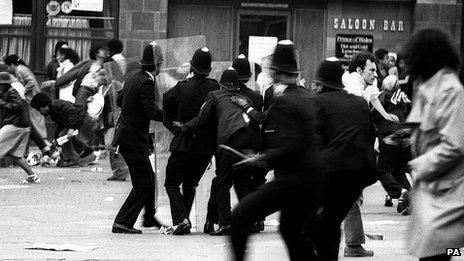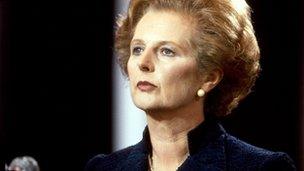Thatcher 'considered arming police' during 1981 riots
- Published

Historian Lord Hennessy says there are "uncanny" similarities between the riots of 1981 and 2011
Margaret Thatcher considered arming the police during the riots of 1981, newly-released National Archives files have shown.
These were the worst civil disturbances in England since 1919, according to contemporary historian Lord Hennessy, and had no parallel, in scale, until the riots last summer.
While there are many differences, the similarities between the riots of 1981 and 2011 are "uncanny", he says.
The then prime minister's personal file on the riots reveals she was warned in April that "spontaneous disorder" was "likely" among the country's ethnic minority communities by a secret Home Office report.

Mrs Thatcher and her home secretary agreed sending in the Army "could not be contemplated"
Britain was in recession. Unemployment was high, especially among the young, and among Britain's black and Asian population.
There was also considerable tension between police and some communities. There had been fierce riots in Brixton, south London, that month lasting several days.
TV news had shown police officers in their everyday helmets and uniforms, cowering behind flimsy-looking riot shields as bricks and bottles were hurled at them.
That happened again, as riots broke out in Toxteth, Liverpool, on 3 July, before erupting in other English cities.
Like last summer, police struggled to keep control of the streets and mass media were blamed for encouraging copy-cat rioting. But in 1981 the disorder took place mostly in the deprived inner city, rather than spreading to the suburbs.
The file gives an unusually detailed picture of how Mrs Thatcher responded, according to Lord Hennessy. He describes it as "almost blow by blow, minute by minute".

The police appealed for new legislation and a shopping list of riot gear
For instance, on 11 July, in the morning, she talked to her Home Secretary Willie Whitelaw.
He had just visited Manchester and Liverpool and reported that there was now "widespread anxiety" about civil unrest in London, and properties were being boarded up across the city.
There had been reports of disorder in many parts of the capital. Just the night before, according to the file, there had been rioting in Brixton, Battersea, Clapham, Streatham, Hackney and Acton.
Cars had been burned in Southall, and petrol bombs thrown in Dalston. Stoke Newington police station had been attacked.
Mrs Thatcher and Mr Whitelaw discussed how to get better equipment for the police, and briefly touched on the idea of sending in troops - something a Liverpool MP had called for.
They agreed that using the Army "could not be contemplated". They would prefer to arm the police, the record notes.
That very evening Mrs Thatcher visited the Metropolitan Police and spent more than seven hours with the commissioner, only leaving New Scotland Yard at three in the morning.
The police had appealed for a new Riot Act and they had also given her a shopping list of riot gear - shields, protective clothing, water cannon, CS gas, rubber bullets and surveillance helicopters.
New tactics, new equipment, "saturating" the cities with police, ended the riots.
"An age of innocence" had ended, according to Lord Hennessy. "People thought riots couldn't happen here - but they did."
The police got their equipment but they didn't get the new law immediately - it was only in 1986 that a new Public Order Act was passed.
Is there any lesson for today's politicians?
Lord Hennessy says while there is a great danger of excessive prime ministerial power in this country, in such circumstances "the prime minister has to speak out, to take a lead" as Mrs Thatcher did.
- Published30 December 2011
- Published30 December 2011
- Published20 December 2011
- Published20 December 2011
- Published28 November 2011
- Published10 April 2011